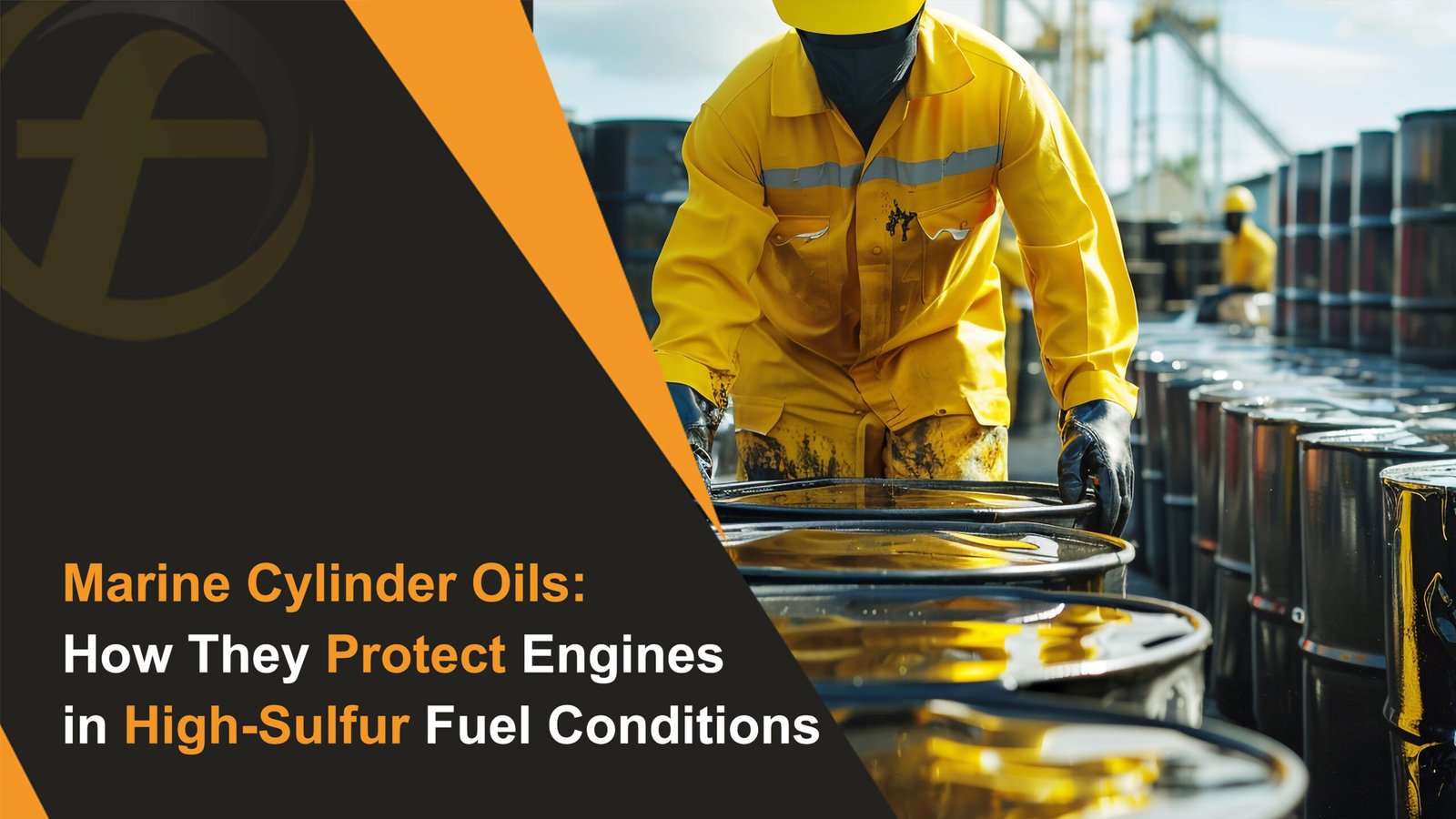
Marine engines work under tough conditions, especially when using fuels that contain sulfur. Without proper protection, engine parts can suffer from friction, corrosion, and wear. This is where marine cylinder oils play a vital role. They create a protective film between piston rings and liners, helping engines run smoothly on long ocean voyages.
At Fubex Lubricants, we offer high-quality marine cylinder oils for all types of engines. Enjoy fast shipping, a price match guarantee, and no-questions-asked returns. Need help choosing the right oil? Call us at +971 50 544 9614 — our friendly team is ready to assist!
Over the years, changes in fuel sulfur limits and cost-saving practices like slow steaming have created new challenges, such as cold corrosion. Choosing the right cylinder oil and using the correct lubrication methods are essential to protect engines, improve performance, and extend their service life.
Key Concepts
- Marine diesel cylinder lubricants create a protective oil film between the piston rings and liners in large ship engines. This helps reduce friction and wear in cargo ships that travel worldwide.
- The sulfur content allowed in marine fuels changes in different parts of the world. Because of this, different types of lubricants have been developed. This problem started to improve when the IMO introduced a global 0.5% sulfur fuel cap in 2020.
- To save fuel costs, many shipping operators use slow steaming (running engines at lower speeds). However, this can cause cold corrosion because of lower engine temperatures. The best way to reduce cold corrosion is to closely monitor engine wear.
What Are the Methods of Marine Engine Lubrication?
Marine engines need proper lubrication to run smoothly and avoid damage. There are four main types of lubrication used in marine engines:
Hydrodynamic Lubrication
In this method, the engine oil makes a thick film between moving metal parts. This film is created by the movement of the parts themselves. The oil film keeps the metals from touching directly.
- Example: Bearings in the main engine, like thrust bearings and journal bearings, use this method.
Hydrostatic Lubrication
Here, the oil film does not form on its own. Instead, an external oil pump pushes the oil under pressure to keep parts separated. The oil pressure and the space between the parts are very important in this system.
- Example: Crosshead bearings in marine engines need this type of lubrication.
Boundary Lubrication
Sometimes, a full oil film cannot form. In this case, only a thin layer of oil separates the moving parts, which means there is some metal-to-metal contact. This creates more friction.
- It usually happens at low speed, high load, or when the oil is too thin (low viscosity).
- Example: When a shaft starts moving from rest.
Elastohydrodynamic Lubrication (EHD)
In this method, the surfaces change shape slightly due to heavy pressure. The oil film also changes in thickness and shape to protect the parts. This usually happens between rolling and sliding parts.
Lubricating Oil Systems in Boat Engines
Boat engines have three main oil systems to make sure all parts are protected:
- Main lubricating oil system
- Cylinder oil system
- Turbocharger lubricating oil system
The Main Lubrication System
The crankcase lubrication system has two pumps. One pump works all the time, while the other stays on standby. If the first pump fails or the oil pressure drops, the second pump automatically takes over.
The lubricating oil travels through a telescopic pipe to the crosshead. From there, it moves through different parts of the main engine:
- Piston – the oil cools and lubricates it.
- Crosshead bearing – the oil keeps it moving smoothly.
- Other parts – the oil continues to flow to the hydraulic power unit, where it lubricates thrust bearings, moment compensators, and torsional vibration dampers.
The Turbocharger Lubricating Oil System
A turbocharger is a fast-spinning part of the engine. It uses exhaust gases to rotate a turbine, which pushes fresh air into the combustion chamber. This helps the marine engine produce more power and perform better.
Because a turbocharger spins at very high speeds and handles heavy loads, its bearings must be strong and well-lubricated.
Turbocharger Bearings: Key Features
- Handles Heavy Loads – The load increases when the engine runs, so the bearings must support it.
- Thermal Stability – Boat engines face both very hot and very cold conditions, so the bearings must work well in all temperatures.
- Consistent Performance – The bearings should keep running smoothly even in tough conditions, like when the oil gets contaminated.
- Oil Compatibility – Bearings must not react with the lubricating oil, so the system stays safe and reliable.
The Role of Lubricants and Additives
Marine engine cylinder lubricants play a vital role in protecting pistons and cylinder liners. Their primary job is to reduce friction and wear, while also neutralizing acids that could cause corrosion and shorten the life of the liners.
One major concern is cold corrosion, which occurs in large, modern engines running on high-sulfur fuels. In these engines, cooler operating temperatures allow acidic sulfur gases to condense on liner walls, leading to serious damage. To combat this, special additive packages with highly alkaline detergents are used. These additives increase the oil’s base number (BN), providing stronger acid neutralization while also cleaning deposits and wear residues.
In addition, cylinder oils must handle extreme heat inside the combustion chamber without breaking down. That’s why the right blend of additives is essential — ensuring protection against corrosion, effective cleaning, and reliable thermal stability.
Types of Turbocharger Bearings
Turbocharger (TC) bearings are placed on the TC shaft. Depending on their location, they can be outboard bearings or inboard bearings.
Outboard Bearings
- These bearings are placed on the outside of the turbine and compressor blade.
- They usually use ball or roller bearings, but newer designs also allow sleeve bearings.
- Main advantage: They are easier to reach, replace, and service. You don’t need to remove the compressor wheel, which saves time and effort.
- Drawback: They are sensitive to heavy loads and can wear out quickly if the lubrication system isn’t maintained properly.
Lubrication System for Outboard Bearings Includes:
- Ball or roller bearings with a built-in gear-type pump.
- An independent oil sump on both sides of the TC casing, where the pump pulls oil from.
- A sight glass in the casing to check oil levels for easier maintenance.
Inboard Bearings
- These bearings are located inside the turbine and compressor blade on the shaft.
- They usually use sleeve white metal bearings.
- They do not have a separate oil sump. Instead, lubrication comes directly from the main lube oil system, using a gravity tank.
Advantages of Inboard Bearings:
- Take up less space than outboard bearings.
- Have better cooling, so they perform well at high temperatures.
- Last longer and need servicing less often.
Disadvantage:
- Harder to access for repairs. To replace or service them, the rotor must be removed.
- Higher risk of oil contamination, since they use oil from the main lube oil system.
The Cylinder Lubrication System
The cylinder lubrication system is separate from the main oil system. Its job is to lubricate the piston rings and keep the engine running smoothly.
Main Roles of the Cylinder Lubrication System:
- Reduce friction between the piston rings and the cylinder liner wall.
- Create a protective seal between these parts.
- Protect against corrosion.
- Clean the cylinder by removing fuel and oil contaminants.
Important Note: The alkalinity of the cylinder oil should match the sulfur content of the heavy fuel oil (HFO) being used. For example, if your engine uses low-sulfur fuel, you should contact the oil manufacturer to find the right cylinder oil.
Types of Cylinder Lubrication Systems
Cylinder lubrication systems are divided into traditional and modern types.
Traditional Systems:
- Timed System – Each cylinder lubricator works in sync with the engine, adding oil at the right time. Used in mechanical and electric systems.
- Accumulator Principle – Works with hydraulic or electric systems. It can add oil before the engine starts because it works independently of engine speed.
Modern Systems:
- Alpha Lubrication – An advanced version of the timed system, using electric or hydraulic technology. It improves timing and helps save oil.
- Swirl Injection Principle (SIP) – Focuses on how oil is spread on the cylinder liner. Instead of just timing or dosing, it creates a strong oil film using as little oil as possible.
Factors to Consider When Choosing Marine Lubricants
Marine engines are powerful, but their parts still face friction, corrosion, and wear and tear. To keep the engine running smoothly and protect its components, it’s important to use the right lubricant.
The lubrication system can either be part of the main engine oil system or an independent system, like the one that protects turbocharger bearings.
Here are the key factors to look for when choosing marine lubricants:
Oil Viscosity
Viscosity means how thick or thin the oil is and how well it flows at different temperatures.
- High viscosity (thick oil): Protects better at high temperatures by forming a strong oil film.
- Low viscosity (thin oil): Flows more easily, especially in cold conditions.
Marine oils can be mono-grade (one thickness) or multi-grade (works in different temperatures). Multi-grade oils are recommended because they perform well in all seasons and conditions.
Alkalinity
When fuel burns, it produces sulfuric acid, which can cause corrosion. A lubricant with the right alkalinity helps neutralize acids and prevent this kind of damage.
Oxidation Resistance
Engines are exposed to oxygen, especially at high temperatures. This can cause sludge, acid, and rust inside the engine. That’s why marine oils include anti-oxidation and anti-corrosion additives to keep the engine clean and safe.
Load-Carrying Capacity
Marine engines have heavy internal parts. The oil must handle this load by forming a strong protective film. If the oil can’t carry the load, parts may grind together, causing friction and faster wear.
High Flash Point
The flash point is the lowest temperature at which oil vapors can catch fire. For safety, marine lubricants should have a flash point above 220°C. This reduces the risk of fire even when oil temperatures rise.
Detergency
Good marine oils contain cleaning additives. These prevent dirt and deposits from building up on engine parts. In two-stroke engines, detergency helps keep the ring pack and combustion chamber clean.
Thermal Stability
Engines generate a lot of heat. The oil should absorb this heat and carry it away to prevent overheating. Oils with strong thermal stability protect the engine by keeping it cool and stable during operation.
Final Takeaways
In conclusion, choosing the right marine cylinder oil is essential to keep your vessel’s engine running smoothly, efficiently, and safely on every voyage. At Fubex Lubricants, we are committed to delivering high-quality oils that protect against wear, corrosion, and extreme operating conditions.
With reliable products, expert guidance, and excellent customer service, we make it simple to care for your marine engines. Trust Fubex Lubricants to keep your fleet performing at its best.
FAQs
Q1: What does sulfur do in engine oil?
Sulfur is used as an additive to improve antioxidant performance, reduce wear, and handle extreme pressure. It also boosts lubricity, helping protect engine parts under tough conditions.
Q2: How is sulfur removed from oil?
Sulfur is removed during refining through hydrodesulfurization (HDS), where hydrogen reacts with sulfur compounds to meet fuel regulations and cut pollution.

Editor-at-Large
A passionate writer in the lubricant industry, Awais Iqbal has been covering oils, greases, and industrial fluids since the start of his career. At 25, he’s already written for blogs, catalogs, and brand guides across the UAE. Awais’s insights help companies connect with their audience, and his clear, helpful writing style is trusted by brands in the region.


